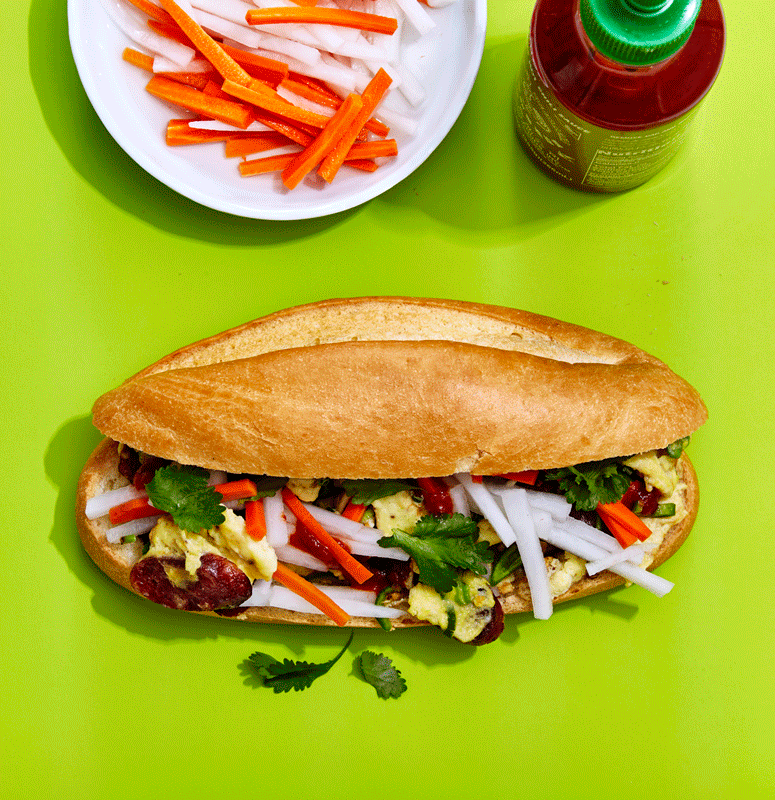
When two childhood cravings merge, a breakfast banh mi is born, full of scrambled eggs and crispy Chinese sausage.
Growing up in New York City teaches you about the workhorse of sandwiches: the BEC, or bacon, egg, and (American) cheese. It’s the grease in the gears that make the city work, clutched by construction workers, day traders, and students alike, functioning much like the oxygen molecules carried by red blood cells as they move through the body.
In high school—while living in Williamsburg, Brooklyn—my routine was to grab an egg and cheese sandwich (I was a vegetarian at the time) from the bodega near the L train stop every other day. Though sometimes I would cough up the extra $.25 to get it on a croissant if I was feeling fancy, the Kaiser roll with poppy seeds on top was my go-to medium for the sandwich. There wasn’t anything particularly special about the rendition found at that bodega: it was just on the way to where I was going. If the train wasn’t too crowded in the morning and I got to sit down, I’d unwrap the sandwich right there and eat it over the bookbag on my lap. If not, I fixated on the moment when I could finally disembark and eat it, having calculated the ideal speed at which to take down my bites without choking as I walked to school from the train station. For all four years, the floor of my locker was perpetually covered in poppy seeds.
On the weekends, I still had eggs for breakfast, but since I didn’t have to eat them on the go, they were scrambled with sliced scallions and served with steamed jasmine rice. Sometimes as a special treat, we’d have it with small, warm loaves of French bread—the same ones you’d use for Vietnamese banh mi. Out of deference for my vegetarianism, my mother would crisp up slices of sweet-and-salty Chinese pork sausage separately so she and my sister could sprinkle them on their eggs along with Maggi seasoning sauce. If I was feeling weak in my ideological resolve, I would surreptitiously take a piece of sausage, dab the aromatic fat on my eggs, and put it back.
The egg-and-Chinese sausage breakfast hits a lot of the flavor and texture notes of the classic American eggs, bacon, and toast plate, from the savory cured pork to the dampening function of the white rice. Its simplicity and ability to accommodate extras like chopped tomatoes, cilantro, and fried shallots makes it a staple of the Chinese-Vietnamese recipe compendium that you can vary enough to eat multiple times a week without getting bored. My grandmother also tended to pull out her frequently replenished jar of quick carrot and daikon pickles to go along with the meal when she made it.
Though many Chinese-Vietnamese families know this dish, you’re not going to find it on most restaurant menus—to most of us, it’s “at home” food that it would be ridiculous to charge money for. (Though perhaps a Vietnamese brunch restaurant could do well these days.)
When I began working full-time in Minneapolis after college, it was hard to find breakfast (they’re not so into bodegas in that part of the country). On a morning when I happened to have a few Vietnamese-style baguettes and a tub of carrot and daikon pickles on hand, I came up with the idea to combine my two favorite breakfasts into one perfect sandwich: the breakfast banh mi. It worked surprisingly well, and the ingredients complemented and complicated each other more immediately than if they were eaten piecemeal with rice. The pickles, thin-sliced jalapeño, and cilantro cut the fattiness of the Chinese sausage while the soft scrambled eggs and Maggi sauce made an excellent substitute for the mayonnaise or pate that usually moisten the sandwich.
While gussied-up takes on the breakfast sandwich have often felt like unnecessary takes on a perfectly good classic, this banh mi works for me because it doesn’t rely on costly ingredients or any notion of being fancy for its appeal. I get to bring a piece of home out into the world with me.